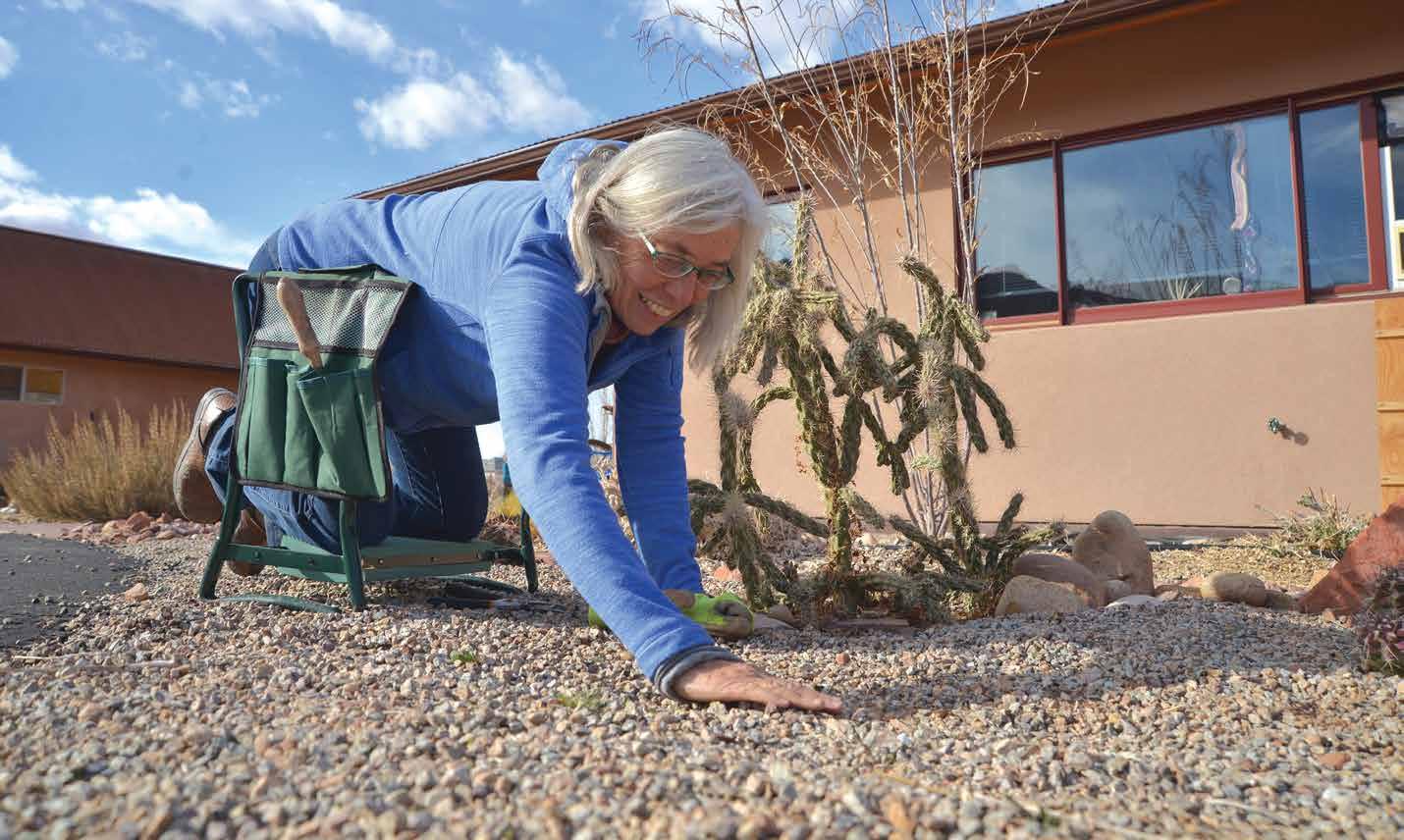
8 minute read
Home sweet house: Maintenance tips from the pros
HOME
SWEET HOUSE
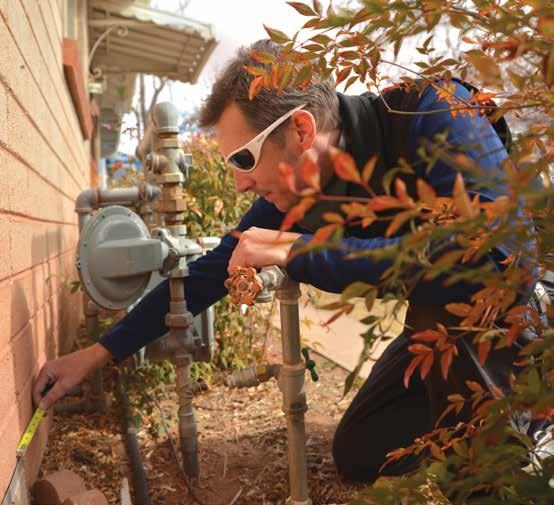
Local experts share their best home maintenance advice
Written by Rachel Fixsen | Photos by Murice D. Miller
FOR MANY, BUYING A HOME IS A DREAM COME TRUE, ESPECIALLY IF THAT HOME IS SURROUNDED BY THE SNOW-CAPPED LA SAL MOUNTAINS AND THE RED ROCK RIMS ABOVE MOAB VALLEY. HOWEVER, HOMES REQUIRE REGULAR MAINTENANCE TO CONTINUE TO FUNCTION PROPERLY, MAINTAIN THEIR RESALE VALUE, PROTECT THE HEALTH AND SAFETY OF THEIR RESIDENTS, AND TO PREVENT EXTREME REPAIR COSTS DOWN THE ROAD. MANY MAINTENANCE ITEMS ARE NECESSARY FOR ANY HOME IN ANY LOCATION, BUT SOME TASKS ARE ESPECIALLY IMPORTANT IN MOAB’S DESERT CLIMATE. LOCAL REALTORS AND HOME INSPECTORS SHARE THEIR ADVICE ON TAKING CARE OF MOAB HOMES.
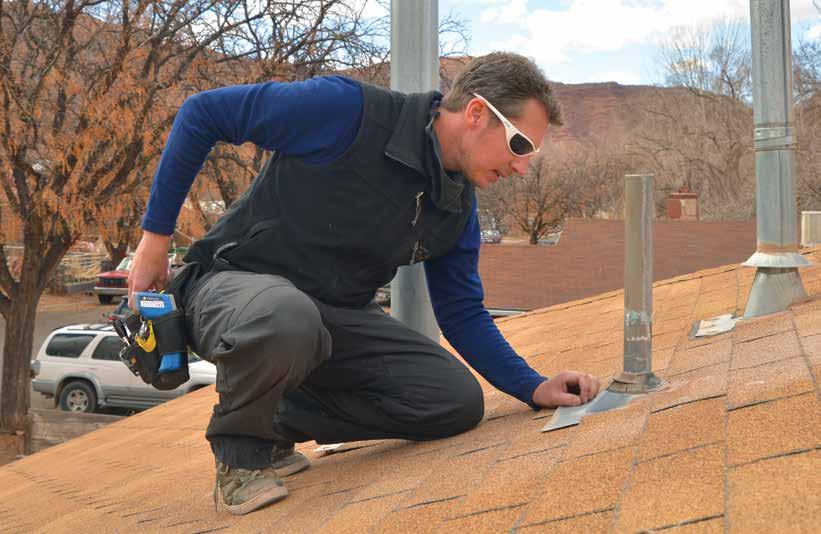
THE BASICS
Some maintenance tasks are readily apparent, like water leaks, cracked caulking, or damaged paint. However, as Sue Dalton, realtor for Anasazi Realty in Moab, says, it’s easy to get accustomed to a small imperfection and start to overlook it.
“You get used to it, so it becomes a nonissue,” she says. However, taking care of those small tasks early is a good idea. Well-maintained systems operate more efficiently, reducing utility costs and preventing damage. Dalton also notes that small, seemingly dismissible problems can become catastrophic if ignored.
“If you get a leak under your sink, fix it right away, because a little leak is easier to fix than having it get worse and blow apart,” she says. She also recommends checking the caulking around bathtubs once a year, a simple step that can avoid mold and mildew problems.
Lynda Diem, realtor for Berkshire Hathaway, recommends repainting interiors, or at least touching up, every eight or ten years, “to prevent a faded, tired look.”
Periodically, you may need to replace electrical or plumbing fixtures, windows, appliances, or other items in your home. Dave Bierschied of Moab Realty advises homeowners to “buy decent stuff.” The fixtures will be more efficient, have more aesthetic appeal, and have a longer life. Even if you are renting the home out to someone else, residents are more likely to take care of good quality fixtures.
Be sure to complete seasonal chores like removing leaves from gutters, trimming weeds around exterior air conditioning units, and cleaning up the exterior of the property. Many homes in Moab use swamp coolers; these should be drained and winterized when the temperatures start to drop. Grand County Building Inspector Bill Hulse says that if you look at rooftops as you drive through town, you’ll see stains on some of them from leaking or overfilled roof-mounted swamp coolers. While you’re looking at your roof, Dalton advises that you check to make sure no shingles have blown away, and that they’re still in good condition. Some home maintenance tasks aren’t as obvious, but they’re no less important.
“We have an issue with water heaters,” says Hulse, explaining that if the tanks aren’t rinsed every six months to a year, the minerals in Moab’s “hard water” can build up inside. He says he’s seen calcium deposits in water heaters as thick as one foot.
Another important item, Hulse says, is drainage away from your home’s foundation. There should be six inches between the siding material of the house and the ground, and the grade should slope away from the house by six inches in every ten feet.
The soil level can be affected by windblown sand piling up against buildings over time. Sometimes gardeners add mulch to their flowerbeds year after year, gradually raising the top of the grade. If that gets too close to the siding, Hulse says, just a couple of inches of snowfall might end up against the siding and moisture could wick up the material, causing damage.
Several experts mentioned changing filters on furnaces, air conditioners, and swamp coolers.
“That’s something we see really often in real estate. People don’t change their filters and then their furnaces don’t run as well,” says Dalton. She recommends changing them every few months. Bierschied adds that HVAC vents should also be cleaned of dust and cobwebs.
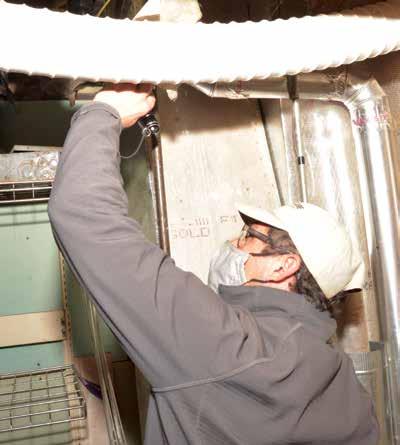
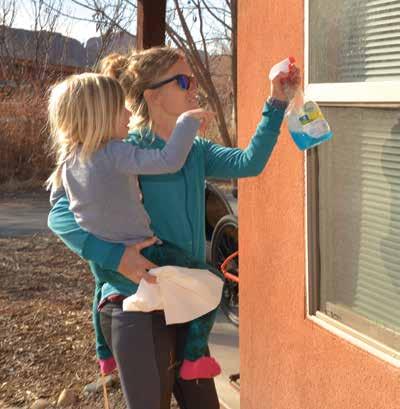
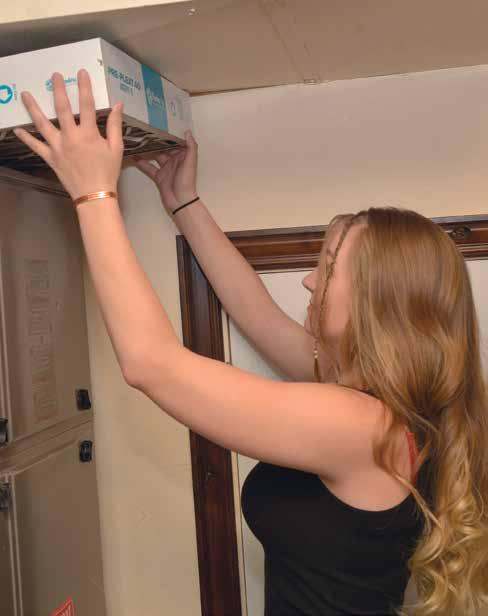
Opposite page, top: Miriam Graham works on the landscaping in front of her home. Experts recommend that the ground next to a home should slope gently away, to prevent water intrusion. Opposite page, middle: Home inspector Chris Bolos checks that the ground is a sufficient distance from the homes siding. Top: Chris Bolos checks the seal around a roof vent. Middle: Home inspector Steve McClure checks a home's furnace. Bottom: Leann Trim and daughter Maeve clean the windows of their Moab home. Right: Toni McElhaney prepares to change her home's furnace filter.

“People miss this all the time,” he says.
Moab home inspector Chris Bolos, owner of Oasis Inspections, is also vigilant about HVAC maintenance.
Dalton says people often overlook certain areas when redecorating.
“A lot of houses will have cracked and peeling paint on the fascia and soffit,” she says. “People forget to look up when they go out of their house. So that’s something they kind of fall behind on.” ESPECIALLY IN MOAB
Home inspector Steve McClure says the most overlooked issue that he comes across in his work in Moab is the impact of sun and the rain.
“The sun is extremely powerful out here, and people do not maintain sun protection on their houses,” he says. Protecting a home’s exterior from the sun means regularly refreshing the paint or stain on wood surfaces. Other experts echo that advice: keep your exterior in good condition by maintaining the paint or weatherproofing finish. Stucco, a popular exterior finish in desert towns like Moab, also benefits from a coat of paint: it can seal out moisture, protect from the sun, and fill hairline cracks. Diem adds that a wood front door should also be kept freshly painted or stained.
Dalton notes that the Moab area is home to both subterranean and drywood termites, another reason to keep wood exteriors well-sealed.
“Drywood termites can get into any little crack,” she says.
The other blind spot McClure has noticed in inspecting Moab homes is rain.
Other experts agree.
Bierschied agrees, and adds that gutters and drainage go hand in hand.
McClure points out an added benefit to installing rain gutters: “Here in Moab you can capture that water and use it in your garden,” he says.
Heading into the warmer weather, inspector Bolos encourages homeowners to keep a close eye on the operation of their swamp coolers.
“[Their] maintenance is often overlooked, as sometimes they are in difficult-to-reach places,” he says. “Checking and changing belts, oiling bushings, and adjusting float levels should be done annually. An improper float level can lead to roof damage, so this is especially important.” FUTURE RESALE VALUE
If you’re actually thinking about selling your home, there are a few simple measures that experts say that homeowners often overlook.
“Curb appeal is the biggest thing in the world,” says Bierschied, advising prospective sellers to take extra care of the landscaping and exterior. If the house doesn’t look cared for and inviting from the outside, it’s unlikely prospective buyers will be interested in touring the inside. One tip he offers for making the front lawn inviting is to “pick up after your dog!”
Bierschied also emphasized that personal items can be distracting to potential buyers. If you are to the point of showing your home, removing very expressive items can allow home shoppers to imagine their own belongings arranged in the space.
For instance, he advises, when it does come time to sell, “Get rid of that wall full of family photos and your trophy animals.”
Dalton offers reminders and tips for deep cleaning the interior of your home. Don’t forget to clean under the refrigerator, and clear dust from the fridge’s coils. This not only looks tidier and improves the air quality, it can help the refrigerator run more efficiently. She also recommends cleaning under and behind the stove, on top of the kitchen cabinets, and cabinet knobs or handles. Wax paper laid on cabinet tops allows for easy disposal of grease build-up. For plumbing fixtures with calcium build-up, she recommends soaking them in a solution of water, vinegar, and dish soap. They don’t need to be removed; a plastic bag filled with the dissolving solution can be fastened to faucets or shower heads with a rubber band.
Dalton also warns against trendy or highly personalized design choices. Busy, colorful tiles might suit your taste, but installed as a kitchen backsplash, they might last for years, and may look dated or be off-putting to a future buyer. Dalton suggests expressing your personal flair through less permanent décor, such as rugs and art pieces.
A well-maintained home will command a much higher value on the market than a “fixer-upper,” says Bierschied. In the long run, spending a few thousand dollars on maintenance now could boost a home’s value in ten-thousand dollar increments down the road. n





